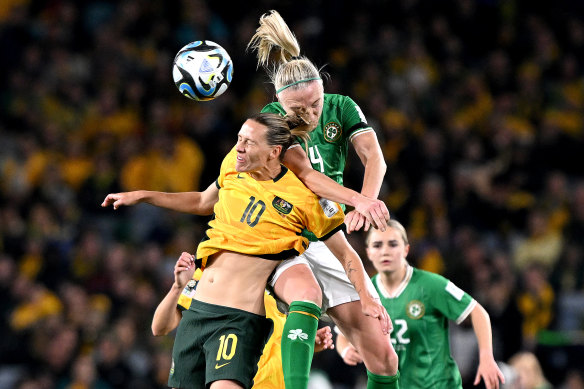How many names can a stadium have?
Save articles for later
Add articles to your saved list and come back to them any time.
So many big matches loom in the FIFA Women’s World Cup. Sorry, make that the FIFA Women’s World Cup® since the tournament is a trademark, a global brand as its schedule reminds us. South Africa, say, is due to play Italy at the Wellington Regional Stadium which any Kiwi will tell you is Sky Stadium.
Just as croweaters know, Coopers Stadium is home to Adelaide United, the 2015-16 champs of the Hyundai A-League Men’s competition, though FIFA won’t hear a murmur of beer or car. Better to disguise the arena in the generic Hindmarsh Stadium, where China and England meet on Tuesday.
“What the heck is Melbourne Rectangular Stadium?” is a fair question Matildas fans might be asking this World Cup.Credit: Getty Images AsiaPac
While on Monday the Matildas tackle Canada at the Melbourne Rectangular Stadium (nee AAMI), every rival brand erased from the record. Just as Suncorp won’t shine for the next three weeks, the insurance giant eclipsed by the no-frills Brisbane Stadium.
If nothing else, the makeover alerts us to the corporate ubiquity across our venues. You don’t see Wimbledon dubbed the Central Marmite Court, or Flushing Meadows getting a five-year deal from Harpic. For all the fixture fuss, on websites and programs, the FIFA revamp has thrown sponsorship into the open, the suppressed brands even more present for being redacted.
Lindy Burns, my predecessor on ABC Victoria’s Evenings show, calls it the Bunnings Syndrome. As host, you’re often wiser to blurt the brand once at the outset, Bunnings in this case, and then go on to refer to it as a hardware store. Compare that to the contortions that editorial policies can inspire, the hapless presenter feeling the need to describe the shop rather than summon its name. Calling it the sausage-sizzling paint depot. Or the Big Green Place. The DIY palace where lower prices are just the beginning.
Take that tack, and soon every listener is thinking Bunnings with a capital B, the brand etched deeper into the subconscious, just as Voldemort’s power resides in the un-speaking of his name.
The other offshoot arising from Stadium Australia, as Accor Stadium shall be briefly known, is what John Sturgis calls the “knobbly monster”. A British journo, Sturgis wrote a piece for The Spectator in 2021 mustering such beasts that infest the media without you realising.
Crocodiles, say, may be identified in an article’s intro, and then afforded more creative epithets beyond that, from swamp snappers to knobbly monsters.
Writers know the device as a second mention, or second reference, where the humdrum of repeating Indiana Jones can be avoided by such descriptors as the Nazi-hating adventure-seeker or the fedora-sporting artefact chaser, as conjured by The Guardian gig guide last week. Nearby, Barbie was “the iconic doll”, while Wham! generated the “bequiffed ’80s pop crooners”.
Vikings – alias the “pugnacious Scandinavians” in a recent History magazine – dubbed such inventive tags as kennings, magicking the ocean into the whale road, the sun into sky candle, and a sword into a wound hoe. You only need to read “the tuber-themed toy” (to quote the UK’s Telegraph) to picture Mr Potato Head, just as “the khaki-clad Ukrainian leader” is as good as the man’s name.
In the Hello Kittification of English, we see many animals likewise labelled, from the flying rat (pigeon) to danger noodle (snake), from hose-nose (elephant) to ropey-gropey (octopus), just as raccoons are trash pandas to the peacock’s disco chook.
Which brings us back to the maple-leaf brigade (aka Canada) taking on our golden girls at a certain oblong oval on Olympic Boulevard. I only hope the fans know how to find the place.
To read more from Spectrum, visit our page here.
The Booklist is a weekly newsletter for book lovers from books editor Jason Steger. Get it delivered every Friday.
Most Viewed in Culture
From our partners
Source: Read Full Article
